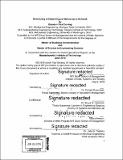| dc.contributor.advisor | Donald Rosenfield and Bruce G. Cameron. | en_US |
| dc.contributor.author | Gorang, Brandon Paul | en_US |
| dc.contributor.other | Leaders for Global Operations Program. | en_US |
| dc.date.accessioned | 2016-09-27T15:15:09Z | |
| dc.date.available | 2016-09-27T15:15:09Z | |
| dc.date.copyright | 2016 | en_US |
| dc.date.issued | 2016 | en_US |
| dc.identifier.uri | http://hdl.handle.net/1721.1/104398 | |
| dc.description | Thesis: M.B.A., Massachusetts Institute of Technology, Sloan School of Management, 2016. In conjunction with the Leaders for Global Operations Program at MIT. | en_US |
| dc.description | Thesis: S.M. in Engineering Systems, Massachusetts Institute of Technology, School of Engineering, Institute for Data, Systems, and Society, 2016. In conjunction with the Leaders for Global Operations Program at MIT. | en_US |
| dc.description | Cataloged from PDF version of thesis. | en_US |
| dc.description | Includes bibliographical references (pages 83-84). | en_US |
| dc.description.abstract | This thesis addresses the allocation of gas turbine aircraft engines to maintenance facilities. Scheduling a global engine maintenance network can be very complex and challenging. This project pertains particularly to the V2500 IAE engine maintenance network managed by Pratt & Whitney. Using a mathematical program to automate engine allocation was believed to reduce the workload on the organization and the cost of maintaining the 3100 engine fleet. An introduction to the engine maintenance network will be covered along with an explanation of Fleet Hour Agreements (FHA). A literature review of mathematical programming is included to provide background of pertinent information. The current state of the business is analyzed. An integer linear program is developed to closely represent the current state of the business. Historical data was used to feed the model, and the outputs from the model were compared to actuals. A sensitivity analysis is performed to better understand the constraints of the current business and the feasibility of the model. An optimization model should not be used to plan engine maintenance given the current state of business. The business is too dynamic and the network is highly constrained by capacity. The results also show a much smaller savings than were originally expected. This is mostly due to better understanding the cost of maintaining the engines at the different shops. The variation was much lower than originally expected. The current state is operating close to optimal with great flexibility and should continue on as is. | en_US |
| dc.description.statementofresponsibility | by Brandon Paul Gorang. | en_US |
| dc.format.extent | 102 pages | en_US |
| dc.language.iso | eng | en_US |
| dc.publisher | Massachusetts Institute of Technology | en_US |
| dc.rights | M.I.T. theses are protected by copyright. They may be viewed from this source for any purpose, but reproduction or distribution in any format is prohibited without written permission. See provided URL for inquiries about permission. | en_US |
| dc.rights.uri | http://dspace.mit.edu/handle/1721.1/7582 | en_US |
| dc.subject | Sloan School of Management. | en_US |
| dc.subject | Institute for Data, Systems, and Society. | en_US |
| dc.subject | Engineering Systems Division. | en_US |
| dc.subject | Leaders for Global Operations Program. | en_US |
| dc.title | Scheduling a global engine maintenance network | en_US |
| dc.type | Thesis | en_US |
| dc.description.degree | M.B.A. | en_US |
| dc.description.degree | S.M. in Engineering Systems | en_US |
| dc.contributor.department | Leaders for Global Operations Program at MIT | en_US |
| dc.contributor.department | Massachusetts Institute of Technology. Engineering Systems Division | |
| dc.contributor.department | Massachusetts Institute of Technology. Institute for Data, Systems, and Society | |
| dc.contributor.department | Sloan School of Management | |
| dc.identifier.oclc | 958269717 | en_US |

